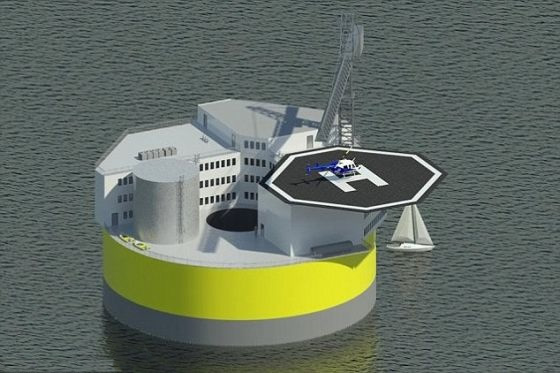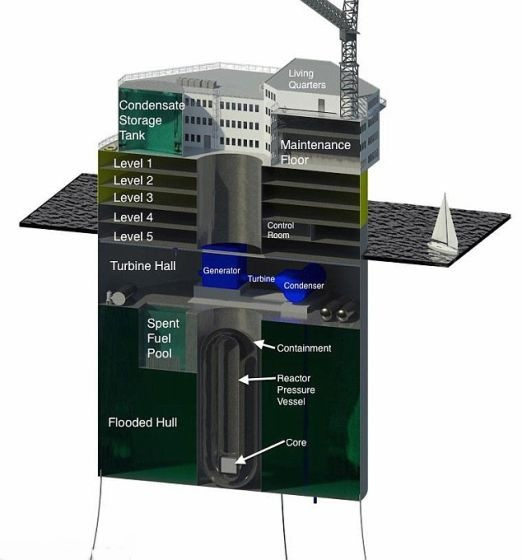Exposing nuclear reactors to the natural environment may not be an ideal practice, but a group of engineers at the Massachusetts Institute of Technology did not think so. They designed a reactor that floats on the sea, not only to withstand the tsunami but also to save lives. In design, this floating reactor can use the surrounding seawater to protect itself in the event of a natural disaster that can lead to a meltdown.

The floating reactor designed by MIT engineers can not only withstand the tsunami but also save lives.

In design, the reactor is placed deep in the sea, and the containment vessel is surrounded by seawater and can use the surrounding seawater for cooling in the event of a natural disaster that can lead to a meltdown.
When an earthquake or tsunami strikes a nuclear power plant, the biggest threat is not the disaster itself but the impact of the disaster. Specifically, it caused the cooling device to fail, and it was unable to cool the reactor core and cause a nuclear accident. In view of this, MIT engineers designed a nuclear reactor floating on the sea, using the surrounding seawater for cooling, to avoid a nuclear accident caused by the cooling device instructions. At a seminar held by the American Society of Mechanical Engineers, scientists will elaborate on this design. MIT professors Jacques Bugino, Michael Gray, Neil Toddle and other scientists will make this suggestion at the meeting.
Scientists point out that placing nuclear reactors on the sea is a reasonable practice and can save lives. In a statement released by the Massachusetts Institute of Technology, Bugino said: “The biggest selling point of this design is to increase the safety factor. This kind of reactor floats on the sea, and the ocean is an almost infinite heat sink that can carry out passive cooling. There is no need for intervention at the same time. The reactor containment is under water.â€
Floating nuclear power plants are not a fresh idea. Russia is building a nuclear power plant on a barge off the coast. If implemented, the design proposed by MIT will be the first reactor in the world to withstand the tsunami. In addition to being able to increase the safety factor, floating nuclear power plants have the advantage of low construction costs. Building nuclear power plants on land requires substantial investment. Land-based nuclear power plants need to be built near water areas, raising the cost and difficulty of construction. As Buggnoo pointed out: "The ocean is an inexpensive real estate market."
In addition to ease of construction, the difficulty of decommissioning a floating nuclear power plant is also low. After the expiry of service, floating nuclear power plants can be towed to related facilities, just like modern naval vessels using reactors. Floating nuclear power plants are designed to be flexible, ranging in size from 50 megawatts to 1,000 megawatts.
Asia may be the largest market for floating nuclear power plants because the local tsunami threat is higher and the demand for electricity continues to grow. “I think the floating nuclear power plant is technically feasible. Of course, scientists need to conduct further research before the idea can be put into practice. The author of the research paper has been found,†said Professor Toshihara Ohara, a professor at the Tokyo University of Technology's nuclear reactor research laboratory. The answer to all questions is a very realistic answer.†When a floating nuclear reactor becomes a reality is still unknown, but there is no doubt that this is a very attractive design that will attract the next few years More people's eyes.
High Speed self-Recovery Rapid doors are the technological evolution of old, PVC high speed doors or heavy folding doors, now obsolete and not suited to today's industrial needs.
High-quality panels, the resistive safety edge fitted to the bottom edge of the door, photocells and barriers make this product both safe and durable, being totally self-repairing, thanks to its special [Anti Crash System".
This door designed with a perimeter structure in galvanized or stainless steel, which is ideal for sliding panels. The door panel rides effortlessly within a track, thanks to the special profile and hinge designed by us, requiring low maintenance. The panel is rolled up on a roller placed within the upper crossbeam.
The door can be equipped with a counterweight or ups batteries, to fully open the door in case of power failure, and can also be equipped with large transparent sections to create a brighter and safer working environment.
Self-Repairing Door Curtain made of reinforced PVC, with flexible weighted soft bottom edge.
The edge of curtain has continuous injection molded teeth that then move up and down in a self-lubricating polyethylene track attached to structural galvanized side frames.
Self-Recovery Rapid Door,Self Recovery PVC Rapid Door,Self Recovery Rapid Rolling Door,Self Healing Roll Door
Shenzhen Hongfa Automatic Door Co., Ltd. , https://www.hfrollershutterdoor.com